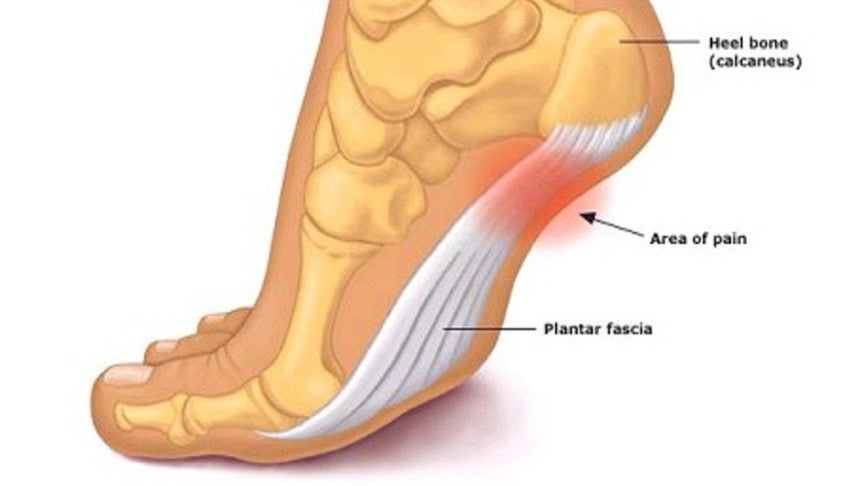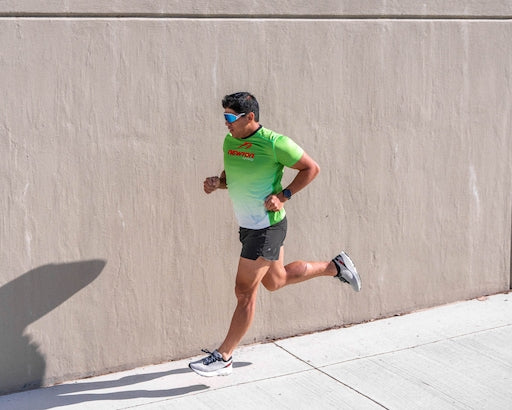
Causes and Treatment of Plantar Fasciitis
overcoming injury running form running science12 October 2018
This post is by Dr. Mark Cucuzella, a Family Physician at Harpers Ferry Family Medicine and Associate Professor at West Virginia University School of Medicine.
 The plantar fascia (PF) is a strong ligament that runs from the heel to the metatarsal heads in the front of your foot. This ligament helps absorb the shock that occurs when your foot contacts the ground. It has function in the windlass mechanism recreating the arch on takeoff.
The plantar fascia (PF) is a strong ligament that runs from the heel to the metatarsal heads in the front of your foot. This ligament helps absorb the shock that occurs when your foot contacts the ground. It has function in the windlass mechanism recreating the arch on takeoff.
Plantar fasciitis is the common term for what should be more accurately termed Plantar Fasciosis. itits is an acute inflammation caused by a trauma or infection. osis is chronic degenerative condition.
No evidence exists for an ideal treatment of this condition without identifying and treating the causes, which can be many. Since we have no literature to guide us, I offer this advice based on my experience treating hundreds of runners and guiding them in self corrections.
What Causes Plantar Fasciitis?
The PF is designed to manage a relatively small amount of stress. The intrinsic and extrinsic muscles of the foot are designed to receive signals from the fascia and in turn manage the majority of the load. When those muscles are dysfunctional, the load is transferred to the PF, which is unable to handle it, and results in tearing.
You can repair these tears by using palliative methods, but PF may return as soon as you resume running. The only way that you can actually fix plantar fasciitis is to address the root cause: weak foot muscles. (Thank you Lance from Barefoot Science for the insight).
Several structural causes can contribute to PF:
- Weak intrinsic foot muscles
- A misaligned and weak first toe
- Tight, shortened calf muscles
- Tight plantar fascia
Other important contributing factors:
- Increased mechanical stress from running or other activity
- Obesity
- Suddenly switching from supportive footwear that inhibit intrinsic foot muscles to flat shoes (flip flops) or barefoot
- Poor walking and running mechanics
- Wearing overly supportive footwear weaken the foot and make it less stable.
How Do You Correct Plantar Fasciitis?
Try a combination of these treatment principles (which is most effective will depend on the cause):
- Using an orthotic, arch support or taping should be a temporary mode of relief while you strengthen and lengthen the tissues. Applying a support device over a long period of time is akin to wearing a cast on a broken arm forever (resulting in muscles atrophy from disuse).
- HTP heel seat is a useful, non-supportive tool for short-term relief while you strengthen the foot.
- Perform eccentric heel dips from a stair. Place your foot on stair and drop your heels down. It is OK to have a little pain doing this as long as it progressively improves.
- Dorsiflex the big toe to lengthen a tight plantar fascia.
- Gradually stop wearing any type of shoe with a heel during ALL activities.
- Work on foot intrinsics, such as picking things up with your toes and walking barefoot. For more foot exercise ideas, see this video at Heel That Pain.
- Practice natural running technique that involves making light ground contact, reduced loading rate, and more proprioceptive cueing. For more info, check out Chi Running by Danny Dreyer, this instructional video by Newton Running, Evolution Running by Ken Mierke, and the excellent teaching of Lee Saxby of Terra Plana VIVOBAREFOOT (see video).
- Throughout the day, strengthen your big toe by pushing it into the ground as often as you can whenever you are standing. This will wake up the foot muscles and help recreate the arch.
- If you first toe curves inward, consider a straightening product like Correct toes by Dr. Ray McClanahan.
- Use the principle of gradual progression and body sensing when making any changes.
- Avoid NSAIDS (Motrin, Ibuprofen, etc). These drugs interfere with natural healthy healing processes.
- See a good health provider who understands natural running and walking.
- Wear minimalist footwear!
About the Author
Dr. Mark Cucuzella is a Family Physician at Harpers Ferry Family Medicine and Associate Professor at West Virginia University School of Medicine. As a Lieutenant Colonel in the Air Force Reserves, he is coach and captain of their marathon team and designing programs to reduce running injuries in military personnel. His passion for health extends beyond the walls of the clinic into the medical home’s “backyard”- the trails and open space that create the arena for optimum wellness.
Read more about Mark on his website: http://www.trtreads.org

